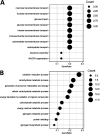Saccharomyces cerevisiae Gene Expression during Fermentation of Pinot Noir Wines at an Industrially Relevant Scale
- PMID: 33741633
- PMCID: PMC8208162
- DOI: 10.1128/AEM.00036-21
Saccharomyces cerevisiae Gene Expression during Fermentation of Pinot Noir Wines at an Industrially Relevant Scale
Abstract
Saccharomyces cerevisiae metabolism produces ethanol and other compounds during the fermentation of grape must into wine. Thousands of genes change expression over the course of a wine fermentation, allowing S. cerevisiae to adapt to and dominate the fermentation environment. Investigations into these gene expression patterns previously revealed genes that underlie cellular adaptation to the grape must and wine environments, involving metabolic specialization and ethanol tolerance. However, the majority of studies detailing gene expression patterns have occurred in controlled environments that may not recapitulate the biological and chemical complexity of fermentations performed at production scale. Here, an analysis of the S. cerevisiae RC212 gene expression program is presented, drawing from 40 pilot-scale fermentations (150 liters) using Pinot noir grapes from 10 California vineyards across two vintages. A core gene expression program was observed across all fermentations irrespective of vintage, similar to that of laboratory fermentations, in addition to novel gene expression patterns likely related to the presence of non-Saccharomyces microorganisms and oxygen availability during fermentation. These gene expression patterns, both common and diverse, provide insight into Saccharomyces cerevisiae biology critical to fermentation outcomes under industry-relevant conditions.IMPORTANCE This study characterized Saccharomyces cerevisiae RC212 gene expression during Pinot noir fermentation at pilot scale (150 liters) using industry-relevant conditions. The reported gene expression patterns of RC212 are generally similar to those observed under laboratory fermentation conditions but also contain gene expression signatures related to yeast-environment interactions found in a production setting (e.g., the presence of non-Saccharomyces microorganisms). Key genes and pathways highlighted by this work remain undercharacterized, indicating the need for further research to understand the roles of these genes and their impact on industrial wine fermentation outcomes.
Keywords: Saccharomyces cerevisiae; fermentation; gene expression.
Copyright © 2021 Reiter et al.
Figures




References
Publication types
MeSH terms
Substances
LinkOut - more resources
Full Text Sources
Other Literature Sources
Molecular Biology Databases

